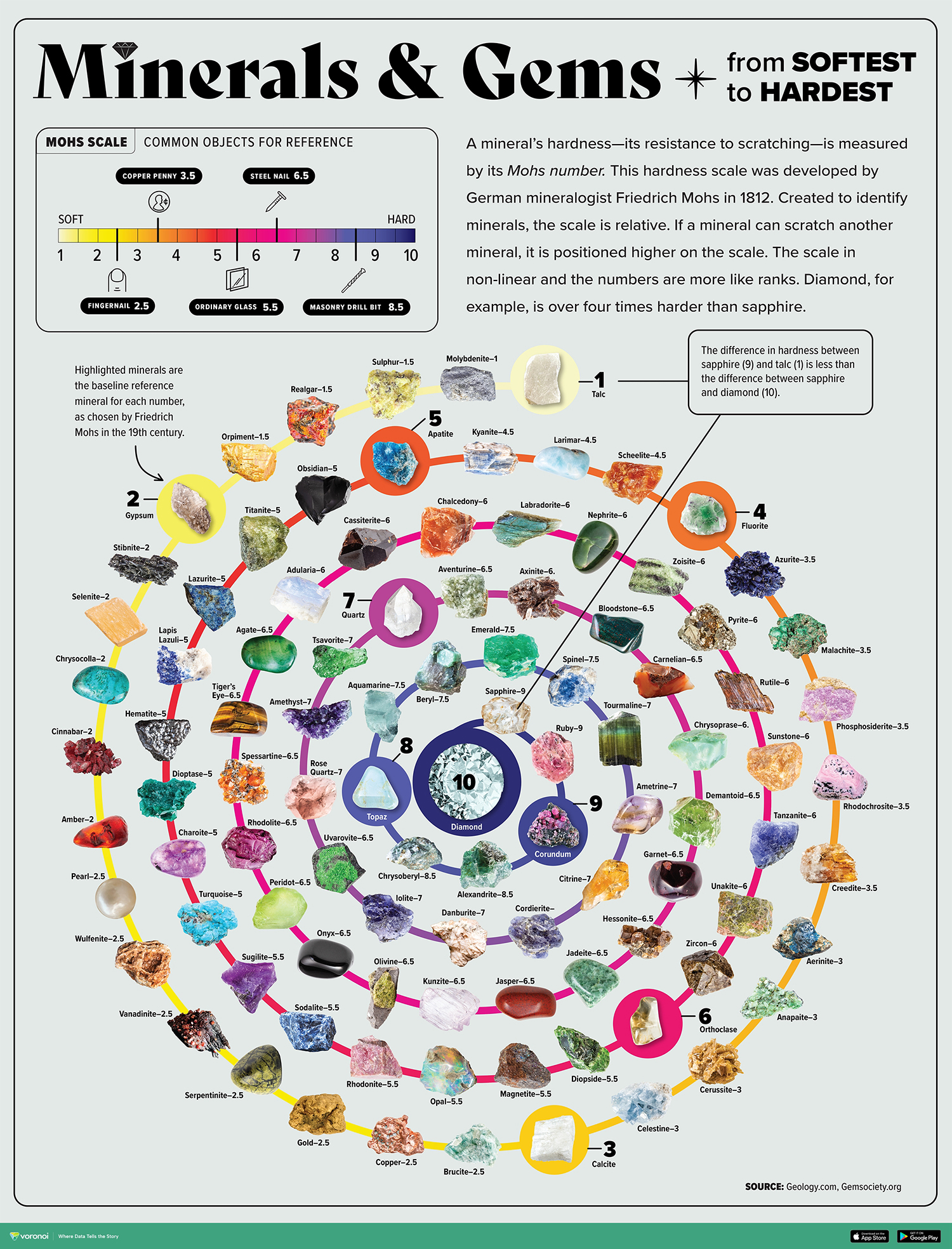Geology 101 nightmares at exam time ;_)
Visualized: Over 100 Minerals and Gems Ranked by Hardness
September 21, 2025
By Julie R. Peasley  Creator Program Ambassador Creator Program Ambassador
Article/Editing:
See this visualization first on the Voronoi app.

Visualized: Over 100 Minerals and Gems Ranked by HardnessThis was originally posted on our Voronoi app. Download the app for free on iOS or Android and discover incredible data-driven charts from a variety of trusted sources.
- The Mohs scale ranks minerals and gems from 1 (softest) to 10 (hardest) based on their resistance to scratching.
- Common items like copper (3.5) and steel (6.5) can scratch many softer minerals but not harder ones like sapphire or diamond.
- Diamond (10) is over four times harder than corundum (9), highlighting a nonlinear increase in hardness at the top end.
The Mohs hardness scale is one of geology’s most practical and enduring tools.
Developed by German mineralogist Friedrich Mohs in 1812, it ranks minerals by their ability to resist scratching—a proxy for their relative durability. Each level on the scale is associated with a “reference” mineral and is increasingly resistant to scratching by the minerals below it.
Mohs selected 10 minerals to define this scale, ranging from soft talc (1) to hard diamond (10). As outlined by Geology.com and the Mineralogical Society of America, this system is still widely used by geologists, gemologists, and industrial designers to quickly compare material strength in the field.
Over 100 Minerals and Gems by HardnessThe visualization above, by Julie Peasley, maps out more than 100 different minerals and gemstones according to their Mohs hardness:
Search:
Gem/MineralMohs Hardness|
| Molybdenite | 1 | | Talc | 1 | | Orpiment | 1.5 | | Realgar | 1.5 | | Sulphur | 1.5 | | Amber | 2 | | Chrysocolla | 2 | | Cinnabar | 2 | | Gypsum | 2 | | Selenite | 2 |
The data shows a wide variety of hardness across different gems and minerals. At the softest end are talc (1) and molybdenite (1), both so delicate they can be scratched with a fingernail. At the extreme other end is diamond (10), the only mineral that can scratch all others. Interestingly, while corundum (which includes ruby and sapphire) is rated 9, diamond is more than four times harder—a reminder that the Mohs scale is not linear.
Hardness in Context: Why It MattersUnderstanding the hardness of a mineral isn’t just academic—it’s highly practical. For example:
- A copper penny (3.5) can scratch calcite (3) but not fluorite (4).
- Steel nails (~6.5) can scratch glass (5.5) but not quartz (7).
- Diamond is not just the hardest mineral, it is a critical component in industrial cutting tools due to this property.
- Some gems prized for their beauty—like opal (5.5) or turquoise (5–6)—are relatively soft, meaning they’re more prone to scratching or wear over time if used in jewelry.
- Meanwhile, harder stones like sapphire (9) and spinel (7.5–8) offer both brilliance and durability, making them ideal alternatives to diamonds.
Further ObservationsQuartz (7) sits in a sweet spot: it’s harder than most household objects, which explains its longevity in nature and popularity in jewelry.
Talc (1) and gypsum (2) are so soft that they can be powdered by hand, yet they are still used in everything from cosmetics to drywall.
Interestingly, some visually similar minerals like fluorite (4) and apatite (5) can have markedly different hardness ratings, which can help in their identification.
What to learn more about gemstones? Check out our deep dive on birthstones and their unique origins. |





